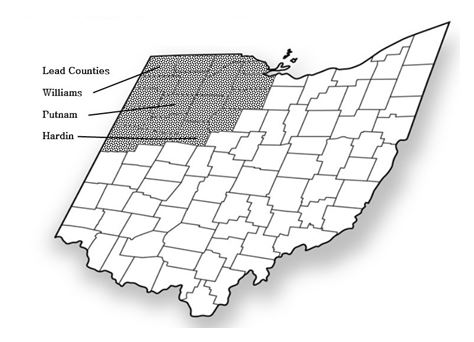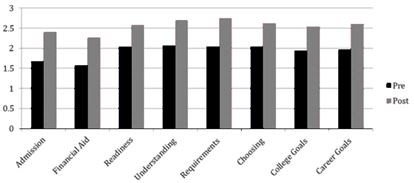 |
December 2013
|
December 2013 // Volume 51 // Number 6 // Ideas at Work // v51-6iw2
College Readiness for Rural Youth Initiative: Creating a Climate for Success
Abstract
College Readiness for Rural Youth is an innovative, postsecondary education bridge program that gives youth the opportunity to explore college attainability, admissions, financial aid, and application processes. The initiative aims to support academic success and transition to college for rural youth.
Introduction
Rural high school graduates are less likely to graduate from college than their urban counterparts, mostly because they are less likely to attend college (Gibbs, 1995). Creating a climate of success for rural youth in Northwest Ohio is the goal of the College Readiness for Rural Youth initiative. Due to the large geographic area targeted, Extension has engaged collaborating partners to develop and facilitate "bridging" programs to support academic success and transitions to college for rural youth in the region.
Over 600,000 students attend Ohio's 13 public university main campuses, 24 university regional campuses, one freestanding medical college, 23 public community and technical colleges, and 63 independent colleges and universities (Riley, 2008). The availability of post-secondary institutions in Ohio is abundant. In fact, most Ohio residents live within 30 miles of a college or university campus (Riley, 2008). However, local availability alone does not make it easy for youth to go to college. Young adults recognize that barriers exist to implementing their future career choices and seek ways to overcome these obstacles (Ferry, 2006). In Ferry's study, she found that youth voiced that the lack of financial resources to attend additional schooling or training was a major barrier. Furthermore, she noted for college-bound youth, the second most identified barriers were college acceptance and being capable of graduating.
In Ohio, more than one-third of recent high school graduates must enroll in remedial math and/or English in college (Ohio Board of Regents, 2012). The state's share of instruction dollars for remedial coursework was over 32 million dollars across all public education sectors in Ohio in FY 2007 (Riley, 2008). According to an article posted in the online Daily Yonder in 2009, 16.8% of adults in rural counties had at least a B.A. degree (approximately half the urban rate). The maps provided in the article also indicated that most of rural Northwest Ohio has a "well below average; less than 14 percent" of its adult population holding a college degree. It is increasingly important that we address this issue from both an economic and college success for youth standpoint. Because the Northwest Ohio region is mostly rural, consisting of 22 counties that cover over 9,400 square land miles, and within these counties there are over 140 high schools, it is unmanageable to address this problem alone.
The Program
We have linked the College Readiness for Rural Youth program with the OSU Extension program entitled Real Money—Real World (RMRW). RMRW is a successful financial literacy program 4-H professionals use in Ohio in partnership with local schools. The curriculum was created by Ohio State University Extension professionals to simulate real-life experiences to help make youth aware of the money management skills they need to be productive and successful adults (Bridgeman, et al., 2003). Results of a 2009 follow-up survey indicated that the program made a dramatic difference in raising youth awareness about the costs to maintain a household, as well as an awareness of the interrelationships between education, job, and money (Bateson & Ferrari, 2009).
We also capitalized on the Extension/local school partnerships to integrate the College Readiness for Rural Youth initiative. An expanded series of activity-based lessons were developed that included multiple topics covering college transition. These lessons helped students identify what steps need to be taken, educationally and financially, to attain their career goals. After youth participated in RMRW, they were then engaged in follow-up activities about how to choose a post-secondary school, what types of programs to explore, how to finance schooling, and how to begin the process of admissions. Students also gained insight as to why good ACT scores, high GPA's, and college prep course work were critical in high school. The overall program has aligned with the Ohio Department of Education Personal Finance Curriculum, thus helping schools partially fulfill their requirement to teach Financial Literacy (part of Amended Ohio Senate Bill 311).
The authors located in Extension offices within Hardin, Putnam, and Williams Counties were designated to lead other counties in the region to cover the broad area of Northwest Ohio in the execution of this curriculum (Figure 1). Each of these designated counties represented strategic locations within the region to service the southern, central, and northern areas, respectively. In addition, the college-readiness curriculum has been implemented through the region in collaboration with partnerships developed with local post-secondary institutions including: Owens Community College, Rhodes State College, Ohio State University Lima, Bowling Green University, and University of Northwestern Ohio. Each of these partners hosted a College Readiness for Rural Youth event.
Figure 1.
Northwest Ohio counties that participated in College Readiness for Rural Youth (shaded areas)

Evaluation Results
A total of 3,023 student from 15 counties and 72 schools participated in the College Readiness for Rural Youth Program. There were 1,325 male students and 1,698 female students surveyed. Students ranged from 7th grade to seniors in high school. Their knowledge levels were measured using a pre- and post-test assessment. This assessment used a 3-point Likert scale ranging from 1= know very little to 3= know a lot. Evaluators constructed a simpler 3-point Likert scale measurement that offered three choices rather than five because of the range in audience age. The post-assessment also included questions on the perceived usefulness of the program and a place for write-in comments.
All questions showed an increase in self-reported knowledge, with scores ranging from .93 –1.13 and a mean increase of 1.00 (Figure 2). The students reported the greatest increase in knowledge in the areas of Understanding the College Admission Office and Financial Aid. The areas showing the least amount of change were Choosing a College and Career Goal Setting. It is worth noting, however, that these two categories scored the highest in knowledge in the pre-assessment. The participants had developed higher competencies in these areas through other means. The mean score for usefulness of the program was 2.58 on a 3-point scale and therefore showed a moderately high degree of usefulness.
The top categories of responses when asked, "what was the most useful part of the program?" included: Admission Requirements, Financial Aid, and Choosing a College. Areas that the participants listed as information not covered sufficiently included materials that addressed specific schools, programs, or alternatives to traditional college settings.
Figure 2.
College Readiness for Rural Youth Pre/Post Assessment Results

Discussion
This program serves as an "on the ground" approach to developing the skills and abilities necessary for youth planning to enter post-secondary education to succeed at a higher level. The support and guidance through this bridge program has built the foundation needed to allow for students to envision college opportunity as an attainable goal. The approach is adaptable to fit the needs and demographics of diverse youth groups.
Acknowledgments
College Readiness for Rural Youth was funded by a grant from the Ohio College Access Network (OCAN) in collaboration with the Putnam County Education Service Center (PCESC). We are grateful to OCAN and the PCESC for their support of the project. For more information about the curriculum and implementation please email hedrick.10@osu.edu, light.42@osu.edu, or dick.7@osu.edu
References
Bridgeman, B., Clements, J., Crum, B., Dalzell, J., Hudson, N., King, A., McNeely, N., Varley, I., Williams, R., & Woods, D., (2003). Real Money Real World: A 4-H money management curriculum for youth (4-H 441 GPM). Columbus: Ohio State University Extension, 4-H Youth Development.
Ferry, N. (2006). Factors influencing career choices of adolescents and young adults in rural Pennsylvania. Journal of Extension [On-line], 44(3) Article 3RIB7. Available at: http://www.joe.org/joe/2006june/rb7.php
Gibbs, R., (1995). Going away to college and wider urban job opportunities take highly educated youth away from rural areas. Rural Development Perspectives, v10 n3 p35-44.
Gallardo, R., & Bishop, B. (2011). The B.A. divide. The Daily Yonder. Retrieved from: http://www.dailyyonder.com/ba-divide/2010/10/17/2995.
Bateson, L., & Ferrari, T. (2009). Real Money Real World: Results of the 2009 follow up study. The Ohio State University. Retrieved from: http://realmoneyrealworld.osu.edu/documents/RMRW_FollowUpStudy_execsum.pdf
Ohio Board of Regents. (2012). Fall 2011 public college enrollment and developmental course enrollment rates: High school graduates in 2011 enrolling at an Ohio public college or university in summer or fall 2011. Columbus: Retrieved from: https://www.ohiohighered.org/files/uploads/data/hs_transition/HS_remediation_rpt_fall2011.pdf
Riley, S. (2008). Institutional effectiveness report 2007. UC Clermont College Institutional Research. Retrieved from http://apps.ucclermont.edu/documents_cms/IR/UCCC_Inst_Effectiveness_Report,_FINAL.pdf




